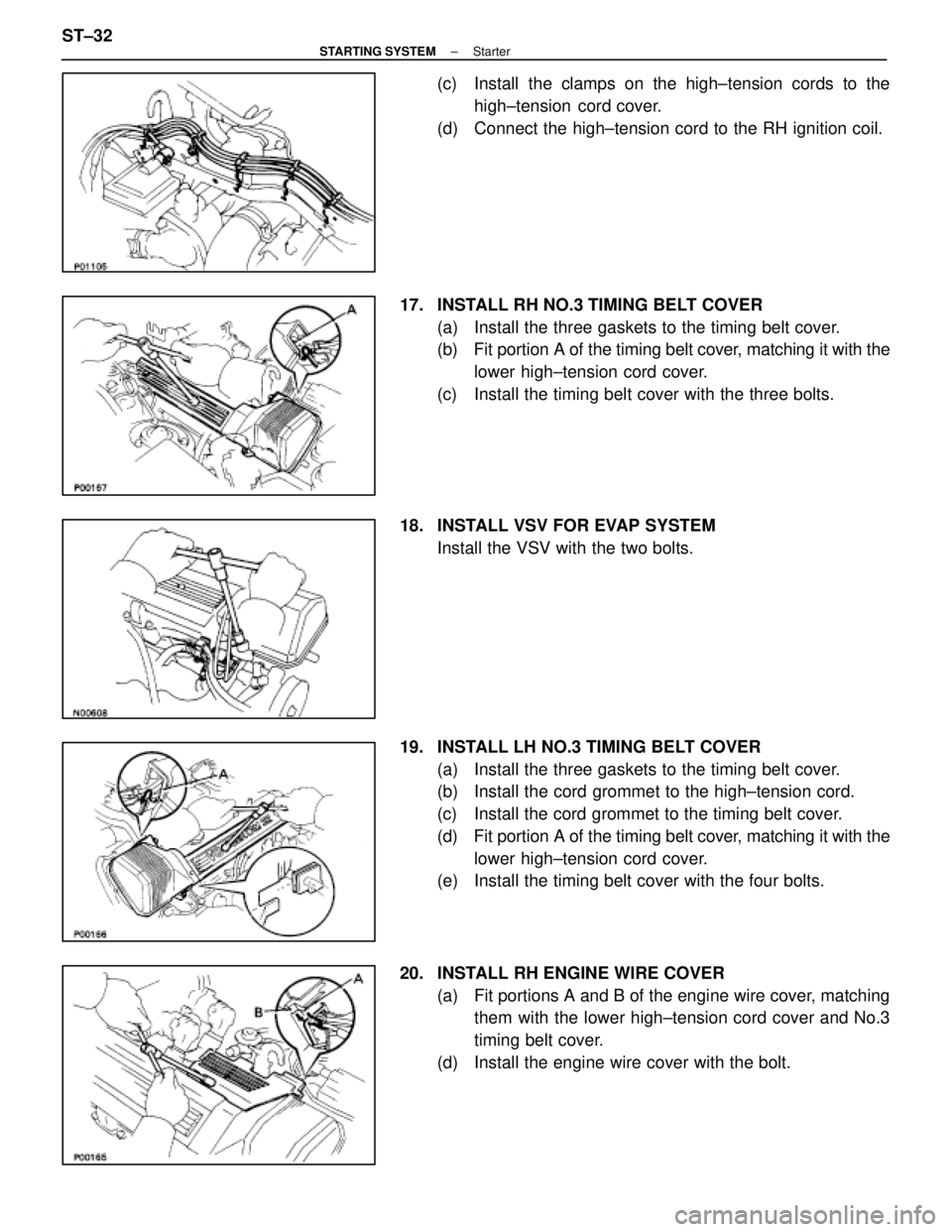Page 2893 of 4087
SYSTEM CIRCUIT
OPERATION
When the ignition switch is turned to START, current flows from terminal 50 to the coil of the solenoid and
the plunger is pulled by the magnetic force of the coil. When the plunger is pulled \
to the left as shown above,
the contact plate of the plunger allows current from the battery to flow di\
rectly from terminal 30 to the motor, and
the starter rotates. When the engine is running and the ignition switch is returned to ON, the ma\
gnetic force of the coil disappears
and the contact plate of the plunger is returned to its original position by the return spring. Battery voltage no
longer flows from terminal 30, so the motor stops.
±
STARTING SYSTEM System Circuit, OperationST±3
WhereEverybodyKnowsYourName
Page 2922 of 4087

(c) Install the clamps on the high±tension cords to thehigh±tension cord cover.
(d) Connect the high±tension cord to the RH ignition coil.
17. INSTALL RH NO.3 TIMING BELT COVER (a) Install the three gaskets to the timing belt cover.
(b) Fit portion A of the timing belt cover, matching it with the
lower high±tension cord cover.
(c) Install the timing belt cover with the three bolts.
18. INSTALL VSV FOR EVAP SYSTEM Install the VSV with the two bolts.
19. INSTALL LH NO.3 TIMING BELT COVER (a) Install the three gaskets to the timing belt cover.
(b) Install the cord grommet to the high±tension cord.
(c) Install the cord grommet to the timing belt cover.
(d) Fit portion A of the timing belt cover, matching it with the
lower high±tension cord cover.
(e) Install the timing belt cover with the four bolts.
20. INSTALL RH ENGINE WIRE COVER (a) Fit portions A and B of the engine wire cover, matchingthem with the lower high±tension cord cover and No.3
timing belt cover.
(d) Install the engine wire cover with the bolt.
ST±32
±
STARTING SYSTEM Starter
WhereEverybodyKnowsYourName
Page 2973 of 4087

ON±VEHICLE INSPECTION
CHECK IDLE±UP
SR0FZ±04
1. WARM UP ENGINE
2. TURN AIR CONDITIONER SWITCH OFF
3. CHECK IDLE±UP
(a) Fully turn the steering wheel.
(b) Check that the engine rpm decreases when the air controlvalve hose is pinched.
(c) Check that the engine rpm increases when the air control valve hose is released.
FLUID LEVEL CHECK
SR0G0±03
1. KEEP VEHICLE LEVEL
2. BOOST FLUID TEMPERATUREWith the engine idling at 1,000 rpm or less, turn the steering
wheel from lock to lock several times to boost fluid tempera-
ture.
Fluid temperature:
805C (176 5F)
3. STOP ENGINE
4. CHECK FOR FOAMING OR EMULSIFICATION
HINT: Foaming and emulsification indicate either the exis-
tence of air in the system or that the fluid level is too low.
5. CHECK FLUID LEVEL IN OIL RESERVOIR Check the fluid level and add fluid if necessary.
Fluid:
ATF DEXRON
[ II
HINT: Check that the fluid level is within the HOT LEVEL of
the dipstick of the reservoir cap. If the fluid is cold, check that
it is within the COLD LEVEL of the dipstick.
±
STEERING POWER STEERINGSR±113
WhereEverybodyKnowsYourName
Page 2974 of 4087
POWER STEERING FLUID
REPLACEMENT
SR0G1±04
1. JACK UP FRONT OF VEHICLE AND SUPPORT IT WITHSTANDS
2. REMOVE FLUID RETURN HOSE FROM OIL RESERVOIR AND DRAIN FLUID INTO CONTAINER
NOTICE: Take care not to spill fluid on the drive belt.
3. TURN STEERING WHEEL FROM LOCK TO LOCK WHILEDRAINING FLUID
4. FILL OIL RESERVOIR WITH FRESH FLUID
Fluid: ATF DEXRON
[ II
5. START ENGINE AND RUN IT AT 1,000 RPMAfter 1 or 2 seconds, fluid will begin to discharge from the re-
turn hose. Stop the engine immediately at this time.
NOTICE: Take care that some fluid remains left in the oil reser-
voir.
6. REPEAT STEPS 4 AND 5 FOUR OR FIVE TIMES UNTIL THERE IS NO MORE AIR IN FLUID
7. CONNECT RETURN HOSE TO OIL RESERVOIR
8. BLEED POWER STEERING SYSTEM (See page SR±115)
SR±114
±
STEERING POWER STEERING
WhereEverybodyKnowsYourName
Page 2975 of 4087

POWER STEERING SYSTEM BLEEDING
SR0G2±04
1. CHECK FLUID LEVEL IN OIL RESERVOIRCheck the fluid level and add fluid if necessary.
Fluid:
ATF DEXRON
[ II
HINT: Check that the fluid level is within the HOT LEVEL of
the dipstick of the reservoir cap. If the fluid is cold, check that
it is within the COLD LEVEL of the dipstick.
2. START ENGINE AND TURN STEERING WHEEL FROM LOCK TO LOCK 3 OR 4 TIMES
With the engine speed below 1,000 rpm, turn the steering
wheel to left or right full lock and keep it there for 2±3 se-
conds, then turn the wheel to the opposite full lock and keep
it there for 2±3 seconds.
3. CHECK THAT FLUID IN OIL RESERVOIR IS NOT FOAMY OR CLOUDY AND DOES NOT RISE OVER MAXIMUM
WHEN ENGINE IS STOPPED
Measure the fluid level with the engine running. Stop the en-
gine and measure the fluid level.
Maximum rise:
5 mm (0.20 in.)
If a problem is found, repeat fluid replacement on page
SR±114. Rep air the PS if the problem persists.
OIL PRESSURE CHECK
SR0G3±03
1. CONNECT PRESSURE GAUGE
(a) Using SST, disconnect the pressure line joint.SC 400:
SST 09631±22020
±
STEERING POWER STEERINGSR±115
WhereEverybodyKnowsYourName
Page 3217 of 4087
2. CONNECT REAR DRIVE SHAFTS
(a) Align the matchmarks on the side gear shaft and drive shafts.
(b) Apply a light coat of engine oil on the threads of the bolts.
(c) Temporarily install the 12 hexagon bolts and 4 washers.
(d) Using a hexagon wrench, torque the bolts.
Torque: 83 N Vm (850 kgf Vcm, 61 ft Vlbf)
3. INSTALL PROPELLER SHAFT
(See page PR±12 or 28)
4. FILL DIFFERENTIAL WITH OIL
Oil grade: API GL±5 Hypoid Gear Oil
Viscosity: Above±18 �C (0 �F) SAE 90
Below±18 �C (0 �F) SAE 80W±90 or 80W
Capacity:
1.35 liters (1.42 US qts, 1.19 lmp qts)
SA±84±
SUSPENSION AND AXLE REAR DIFFERENTIAL
WhereEverybodyKnowsYourName
Page 3330 of 4087
REAR DRIVE SHAFT INSTALLATION
SA0S4±02
1. INSTALL DRIVE SHAFT
(a) Insert the outboard joint side of the drive shaft to the axle hub.
NOTICE:
wBe careful not to damage the boots, end cover and speed
sensor rotor of the drive shaft, and oil seal of the axle hub.
w Make sure the outboard joint side of the drive shaft does
not bend too much.
(b) Align the matchmarks on the side gear shaft and drive shaft.
(c) Apply a light coat of engine oil on the threads of the bolt.
(d) Install the 6 hexagon bolts and 2 washers.
(e) Using a 10 mm hexagon wrench, torque the bolts.
Torque: 83 N Vm (850 kgf Vcm, 64 ft Vlbf)
2. INSTALL EXHAUST PIPE
3. INSTALL LOCK NUT, LOCK CAP AND NEW COTTER PIN
Torque: 289 N Vm (2,950 kgf Vcm, 213 ft Vlbf)
4. INSTALL REAR WHEEL AND LOWER VEHICLE
±
SUSPENSION AND AXLE REAR DRIVE SHAFTSA±67
WhereEverybodyKnowsYourName
Page 3344 of 4087
ECU Power Source Circuit
CIRCUIT DESCRIPTION
When the ignition switch is turned on, battery voltage
is applied to the terminal IG SW of the ECU, and the
main relay control circuit in the ECU sends a signal to
the terminal M±REL of the ECU, switching on the
main relay. This signal causes current to flow to the
coil, closing the contacts of the main relay and supply-
ing power to the terminals +B and +B1 of the ECU.
If the ignition switch is turned off, the ECU continues
to switch on the main relay for a maximum of 2 se-
conds for the initial setting of the ISC valve.
DIAGNOSTIC CHARTDIAGNOSTIC CHART
See next page for the DIAGNOSTIC CHART.
WIRING DIAGRAM
TR±124±
ENGINE TROUBLESHOOTING Circuit Inspection
WhereEverybodyKnowsYourName